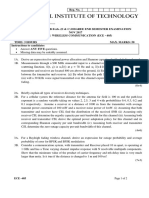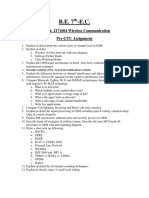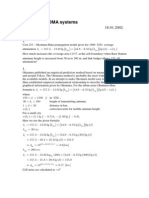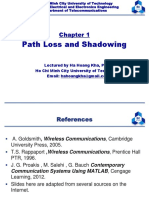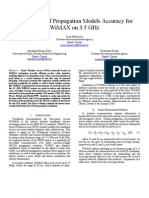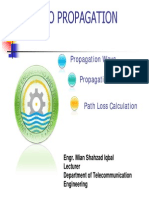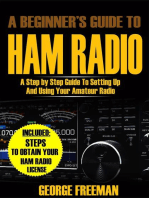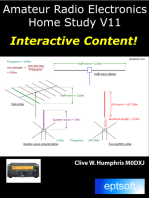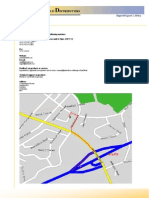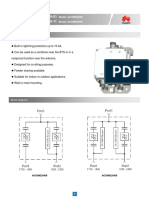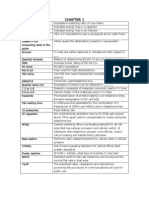Assignment 1 PDF
Uploaded by
Thedre ThuivanAssignment 1 PDF
Uploaded by
Thedre ThuivanEE 3320 - Wireless Communication
Assignment 1, Due Thursday 16-01-2020
Instructor: Prof. Mohammed Zafar Ali Khan, zafar@iith.ac.in
1. Draw signal constellation diagrams for the M-PAM, M-PSK, QPSK and M-QAM schemes.
Write the expressions for transmitted and received signals for each scheme for the additive
white Gaussian noise (AWGN) channel.
2. Derive expressions of the probabilities of error (bit error rate - BER) for the BPSK and 4-
QAM modulation schemes for the AWGN channel. Perform simulations in Matlab and plot
your simulated curves. Also, plot your derived expressions and verify through simulations.
3. Derive the approximate path loss for the two ray path loss model.
4. For the two-ray model, derive an approximate expression for the distance values below the
critical distance dc at which signal nulls occur.
5. Consider the received signal for the 2 ray model, where u(t) = exp(j2πfs t), G1 = G2 = 1,
d = 10 km, ht = hr = 50 m.
(a) Compute the delay spread. Assuming distance d is uncertain within 1%, what range does
the delay spread lie in?
(b) Compute the phase difference between the signal components in the following cases:
(i)fs = 1m where m is the mid point of the range identified above (ii) fs = 21 m (iii)
1
fs = 100 m. In which of the above cases does the approximation u(t) ≈ u(t − τ ) hold best
and why?
6. Consider the ten-ray model described in Section 2.4.2 of the text.
(a) What average power falloff with distance do you expect for the ten-ray model and Why?
(b) Assume that the transmitter and the receiver are at the same height in the middle of a
street of width 20 m and that the separation between the transmitter and receiver is 500
m. Also, the transmitter is very close to the street (i.e. the height is very low). Find the
delay spread for this model.
7. Consider a cellular system operating at 900 MHz where propagation follows free space path
loss with variations about this path from log-normal shadowing with σ = 6 dB. Suppose that
for acceptable voice quality a signal-to-noise power ratio of 15 dB is required at the mobile.
Assume that the base station transmits at 1 W and its antenna has a 3 dB gain. There is no
antenna gain at the mobile and the receiver noise in the bandwidth of interest is -40 dBm.
Find the maximum cell size so that a mobile on the cell boundary will have acceptable voice
quality 90% of the time.
You might also like
- Exercise 1 - Fundamental of Mobile NetworksNo ratings yetExercise 1 - Fundamental of Mobile Networks4 pages
- Simulation of Digital Communication Systems Using MatlabFrom EverandSimulation of Digital Communication Systems Using Matlab3.5/5 (22)
- Ecx6239 - Wireless Communication - 2013/2014No ratings yetEcx6239 - Wireless Communication - 2013/20142 pages
- Assignment 4 Mobile & Wireless Communication (EC - 17101) : T T T TNo ratings yetAssignment 4 Mobile & Wireless Communication (EC - 17101) : T T T T1 page
- Assignment 1 - Solutions: - Compute The Maximum Doppler Frequency F If The Transmitter Is Moving at 72 KMPH0% (1)Assignment 1 - Solutions: - Compute The Maximum Doppler Frequency F If The Transmitter Is Moving at 72 KMPH5 pages
- Wireless Communications: Multipath FadingNo ratings yetWireless Communications: Multipath Fading13 pages
- Path Loss Study of Lee Propagation Model: AbstractNo ratings yetPath Loss Study of Lee Propagation Model: Abstract4 pages
- Comparison of Propagation Models Accuracy For Wimax On 3.5 GHZNo ratings yetComparison of Propagation Models Accuracy For Wimax On 3.5 GHZ4 pages
- Wireless Communication (ECE - 4101) (MAKE UP)No ratings yetWireless Communication (ECE - 4101) (MAKE UP)2 pages
- 14EC2044 - Fundamentals of Wireless Communication - Question BankNo ratings yet14EC2044 - Fundamentals of Wireless Communication - Question Bank7 pages
- Department of Electronics and Communication Engineering National Institute of Technology RourkelaNo ratings yetDepartment of Electronics and Communication Engineering National Institute of Technology Rourkela2 pages
- CS 515 Mobile and Wireless Networking: Bilkent University Computer Engineering DepartmentNo ratings yetCS 515 Mobile and Wireless Networking: Bilkent University Computer Engineering Department10 pages
- Homework Assignment 1: Physical Layer 18759: Wireless Networks (Max. 100 Points) Due Date:8th Feb (In Class)100% (1)Homework Assignment 1: Physical Layer 18759: Wireless Networks (Max. 100 Points) Due Date:8th Feb (In Class)4 pages
- Radio Propagation and Adaptive Antennas for Wireless Communication Networks: Terrestrial, Atmospheric, and IonosphericFrom EverandRadio Propagation and Adaptive Antennas for Wireless Communication Networks: Terrestrial, Atmospheric, and IonosphericNo ratings yet
- HPE Aruba Networking 530 Series Campus Access PointsNo ratings yetHPE Aruba Networking 530 Series Campus Access Points16 pages
- Broadband CPW-Fed Circularly-Polarized Slot Antenna With An Open SlotNo ratings yetBroadband CPW-Fed Circularly-Polarized Slot Antenna With An Open Slot5 pages
- Project Licitación Hospitales PTP Installation ReportNo ratings yetProject Licitación Hospitales PTP Installation Report102 pages
- Book LoRa LoRaWAN and Internet of ThingsNo ratings yetBook LoRa LoRaWAN and Internet of Things140 pages
- Huawei Antenna Product Catalogue 20200515pdf 4 PDF FreeNo ratings yetHuawei Antenna Product Catalogue 20200515pdf 4 PDF Free578 pages
- SG-237 SG237 SGC Autotune Smartuner User Manual PDFNo ratings yetSG-237 SG237 SGC Autotune Smartuner User Manual PDF14 pages
- Unit 3 - 02 FM-Transmitter & Receiver - and Noise PDF100% (1)Unit 3 - 02 FM-Transmitter & Receiver - and Noise PDF29 pages
- EPMP Optimization Parameters - Cambium Networks CommunityNo ratings yetEPMP Optimization Parameters - Cambium Networks Community3 pages




